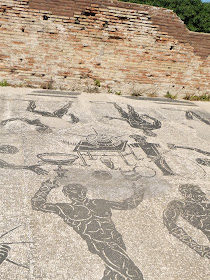Wandering unsupervised in various real and imaginary places. Detritus reflects my interests in robotics, travel, history and the odder aspects of the world around me.
Pages
▼
Monday, July 10, 2017
Fleeing the Crowds at Ostia Antica
Ostia Antica is a site near Rome that is not on the A-list for most travelers. But it should be. As a well preserved town of ancient times it is sort of like Pompeii...but without the lingering sadness of sudden, mass death.
From the above view you might get the notion that Ostia is entirely free of obnoxious tourist mobs. That would not be entirely true, some parts are quite hectic, mostly with Italian school groups milling about. Having been there twice now I feel qualified to offer advice on how to best enjoy the site - how to appreciate the resonance with the past that is just a bit more difficult when navigating among roaming teenagers. But first a little history of Ostia.
Antiquity had relatively few cities that we would consider large by modern standards. The biggest issue was actually feeding significant numbers of people who were not growing their own rations. For Rome the solution was shipping in grain from elsewhere. Ostia literally means "mouth", and was situated at the point where the Tiber meets the sea. Here ships were off loaded and merchandise - mostly food - sent upstream on smaller craft.
Ostia probably got its start under the last kings of Rome, really hit its prime in Republican times and continued to be prominent until a new port, called Portus, was built on the other side of the Tiber. After that Ostia became a more genteel residential district that gradually faded in late Imperial times. Without a great city to feed it declined further in the medieval era, eventually being land locked by a change in the course of the Tiber. Silt filled in the ruins and it was abandoned.
It was of course pillaged for marble and artifacts before being excavated on a purposeful basis beginning in the 19th century. Mussolini really amped up the excavation and restoration project in the 1930s, hoping that Ostia would be one of the centerpieces of his great Universal Exhibition. World War Two happened instead.
Ostia is a large and very complex site. We looked into getting a dedicated guide but our inquiries did not pan out. Everything we found was expensive and "generic". I suggest a visit to Ostia be accompanied by the English translation of Sonia Gallico's book Ostia Antica.
I found a copy very cheap on Amazon.
I'll get to more travel details another day but my first bit of advice is the most important. Get your tickets. Don't bother to buy their map, its not very good. Gallico contains a better one. From the entry point march straight past all the famous things that average tourists are milling about and go to the far end of the site. You will have it all to yourself. And you will see much that is Interesting and Odd.
A small bit of a marble monument. Presumably with a nautical connection as this is a life sized reproduction of the metal rams that Roman warships had on the front.
How about a visit to a dodgy early Third Century Sports Bar? The Caupona di Alexander e Helix is identified as a tavern by its remaining fixtures. The names in its designation come from a pair of mosaics that appear to depict Aurelius Helix and Gaius Perelius Aurelius Alexander, both famous athletes of the era. There are some other mosaics too....this one is politely described as showing "grotesque dancing figures". I think most of us have occasion wandered into a bar, looked around the place and quickly figured out that it was not our kind of place....
If you felt like taking a nice clean shower after that you need only stroll a bit farther out the main street to reach one of the public baths. My map of the site shows an even dozen that have been excavated. This one is the Baths of the Porta Marina out at the far reaches of the site. We had it all to ourselves. It has some enigmatic mosaics.
This one reminds me so much of the Statue of Liberty.
I was surprised to see this athlete using what to all appearances is a modern soccer (foot) ball! I guess there are only so many ways to make such an object.
When you basically have a site to yourself it is possible to both form your own theories and to explore them. I saw this little hut on top of the ruins and figured it had to be entirely made of leftover ancient stone and brick. Of course it was. I had to go up and check it out. It seems to have been a watchman's shed. It naturally had a panoramic view of the site. You saw it at the top of this posting.
Being mooned by Hercules.
As I said earlier, Ostia is like Pompeii, but also unlike it. You don't get the sense of life being wiped out, just that things got old and tired. From a peak population of 50,000 it contracted in on its boundaries and became a genteel suburb, then shrunk further and was a lightly inhabited ghost town until the shifting of political fortunes, sea coasts and the Tiber itself made it obsolete. But life never really stopped here and walking among the houses, shops and public places of Ostia you can still feel the presence of the previous inhabitants to a much greater extent that in other sites we visited.









I really enjoyed Ostia, back in the early 1990s. I second your recommendation that this should be on people's A-list.
ReplyDelete